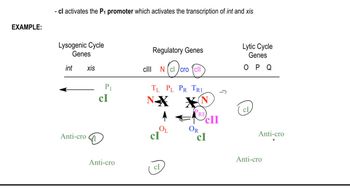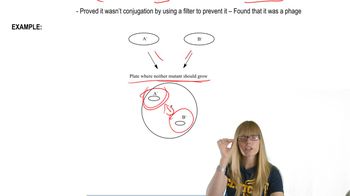A mixed infection of two bacteriophage strains was performed. Infection of bacteriophage strain 1 causes the bacteria to be red and large, while infection of bacteriophage strain 2 causes the bacteria colony to be black and small. The following results were obtained. Using this data, determine the distance between the color and size genes.
Table of contents
- 1. Introduction to Genetics51m
- 2. Mendel's Laws of Inheritance3h 37m
- 3. Extensions to Mendelian Inheritance2h 41m
- 4. Genetic Mapping and Linkage2h 28m
- 5. Genetics of Bacteria and Viruses1h 21m
- 6. Chromosomal Variation1h 48m
- 7. DNA and Chromosome Structure56m
- 8. DNA Replication1h 10m
- 9. Mitosis and Meiosis1h 34m
- 10. Transcription1h 0m
- 11. Translation58m
- 12. Gene Regulation in Prokaryotes1h 19m
- 13. Gene Regulation in Eukaryotes44m
- 14. Genetic Control of Development44m
- 15. Genomes and Genomics1h 50m
- 16. Transposable Elements47m
- 17. Mutation, Repair, and Recombination1h 6m
- 18. Molecular Genetic Tools19m
- 19. Cancer Genetics29m
- 20. Quantitative Genetics1h 26m
- 21. Population Genetics50m
- 22. Evolutionary Genetics29m
5. Genetics of Bacteria and Viruses
Bacteriophage Genetics
Problem 7
Textbook Question
Describe what is meant by the term site-specific recombination as used in identifying the processes that lead to the integration of temperate bacteriophages into host bacterial chromosomes during lysogeny or to the formation of specialized transducing phage.
 Verified step by step guidance
Verified step by step guidance1
Site-specific recombination refers to a type of genetic recombination where DNA strand exchange occurs at specific sequences, rather than randomly across the genome.
In the context of temperate bacteriophages, site-specific recombination is the process by which the phage DNA integrates into the host bacterial chromosome during lysogeny. This integration is mediated by specific recombination sites on both the phage DNA and the bacterial chromosome.
The integration process involves enzymes called recombinases, such as integrase, which recognize and catalyze the recombination between the specific sequences on the phage and host DNA.
During the formation of specialized transducing phages, site-specific recombination can lead to the excision of the prophage (integrated phage DNA) from the bacterial chromosome. If this excision is imprecise, it may include adjacent bacterial genes, which are then packaged into the phage particle.
This process is significant because it allows for the horizontal transfer of bacterial genes, contributing to genetic diversity and the spread of traits such as antibiotic resistance among bacterial populations.
 Verified video answer for a similar problem:
Verified video answer for a similar problem:This video solution was recommended by our tutors as helpful for the problem above
Video duration:
1mPlay a video:
Was this helpful?
Key Concepts
Here are the essential concepts you must grasp in order to answer the question correctly.
Site-Specific Recombination
Site-specific recombination is a genetic process where DNA segments are exchanged at specific sequences, allowing for the integration of foreign DNA into a host genome. This mechanism is crucial for the stable incorporation of temperate bacteriophages into bacterial chromosomes during lysogeny, enabling the phage to coexist with the host without causing immediate lysis.
Recommended video:
Guided course

Recombination after Single Strand Breaks
Lysogeny
Lysogeny is a viral life cycle phase where a temperate bacteriophage integrates its genome into the host bacterial chromosome, forming a prophage. This integration allows the phage to replicate along with the host's DNA during cell division, leading to a stable relationship until conditions trigger the lytic cycle, where the phage becomes active and produces new virions.
Recommended video:
Guided course

Decision Between Lytic and Lysogenic Cycles
Specialized Transduction
Specialized transduction is a process where a bacteriophage transfers specific bacterial genes from one host to another during the lysogenic cycle. This occurs when a prophage incorrectly excises from the bacterial chromosome, taking adjacent bacterial genes with it, which can then be introduced into a new bacterial host, facilitating genetic diversity and evolution.
Recommended video:
Guided course

Transduction

 3:44m
3:44mWatch next
Master Plaques and Experiments with a bite sized video explanation from Kylia
Start learningRelated Videos
Related Practice
Multiple Choice
629
views
1
rank
